
|
Soviet Experimentation with Nuclear Powered Bombers by Raul Colon |
||
|---|---|---|---|
| Home Page | Articles Index | ||
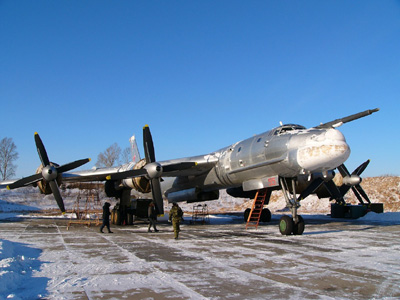
|
The Tupolev Tu-95M was used as a flying test-bed to develop a nuclear powered bomber and was given the designation Tu-95LAL. | ||
|
In the late 1940s, as the Cold War began to heat-up, the Soviet Union began research into the development of nuclear reactors as power sources to drive warships. The work was performed at first by an academic Russian engineer, I.V. Kurchatov, which added aviation as a possible recipient of the new nuclear power plants. On August 12th, 1955 the Council of Ministers of the USSR issued a mandate which ordered certain groups within the aviation industry to join forces in this research. As a direct result of the mandate, the design bureaus of Andrei Tupolev and Vladimir Myasishchev became the appointed chief design teams on a project to develop and produce several aircraft designs intended to be powered by nuclear propulsion while a bureau headed by N.D. Kuznetsov and A.M. Lyulka, were assigned to develop the engines for the aircraft.
They promptly decided on an energy transfer method— Direct Cycle. This method would enable the engines to use energy supplied by a reactor, that would replace the combustion chamber of a jet engine. Several types of nuclear powered engines were tested: ramjet, turboprop and turbojet, with different transfer mechanisms for transmitting the nuclear generated thermal energy. After extensive experimentation with various engines and transfer systems, Soviet engineers concluded that the direct cycle turbojet engine offered the best alternative. In the direct cycle power transfer configuration, the incoming air enter through the compressor mechanism of the turbojet engine, then, passes through a plenum that direct the air to the reactor core. Then the air, by this time acting as the reactor coolant additive, is constantly heated as its move through the core. After exiting the core, the air goes back to another plenum and from there is directed to the turbine section of the engines for thrust production. New coolant systems were also tested, as it was the protective shielding for the crew cabin. This and the size of the initial nuclear power plants were the main problem facing engineers working on the project. Shielding the crew and reducing the size and weight of the reactors in order to fit one on an airframe became the main technical hurdle in the project. The Tupolev bureau, knowing the complexity of the task assigned to them, estimated that it would be two decades before the program could produce a working prototype. They assumed that the first operational nuclear-assisted airplane could take to the air in the late 1970s or early 1980s. The program was design to operate in development phases. The first phase was designing and testing a small nuclear reactor, which properly began in late 1955. On March 1956, the Tupolev bureau was assigned by the Council of Ministers of the USSR the task of producing a flying test-bed plane as soon as possible. The Tupolev engineers decided to take an existing Tu-95M bomber and use it as a nuclear flying laboratory, the plane eventual designation were to be Tu-95LAL. |
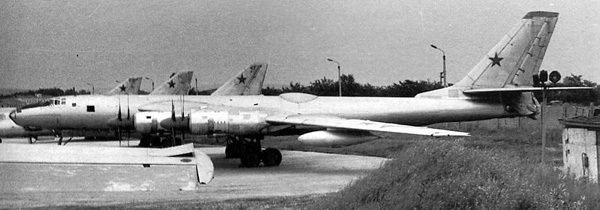 |
| Tupolev Tu-95LAL nuclear test-bed airplane.
|
|
By 1958, the ground phase of the program, the rig used to install the nuclear reactor on the aircraft, was ready for testing. Some time during the summer of 1958, the nuclear power plant was turned on and testing commenced. Immediately, the required level of reactor power was achieved, thus opening the path for the flight test phase.
Between May and August 1961, the Tu-95LAL completed 34 research flights. Much of them made with the reactor shut down. The main purpose of the flight phase was examining the effectiveness of the radiation shielding which was one of the main concerns for the engineers. The massive amount of liquid sodium, beryllium oxide, cadmium, paraffin wax and steel plates; were the sole source of protection for the crew against the deadly radiation emerging from the core. The results were once again promising. Radiation levels were low on the crew cabin, paving the way for the bureau to design a new airframe. The next phase in the program was to produce a test aircraft designed from the beginning to use nuclear power as its main propulsion force. This was to be the Aircraft 119. This aircraft was based on the Tu-95 design. The major distinction was that two of its four engines, inboard, were to be the new NK14a turboprops with heat exchangers. The NK14a operates very similar to the direct cycle engines, the main difference is that the air, after passing through the compressor, does not go to the reactor, it goes directly to the heat exchange system. At the same time, the heat generated by the reactor, carried in the form of fluid; go to the heat exchange system. The combination of these two forces would enable the turbojet to produce the require amount of thrust. The other two outboard engines would remain NK12Ms. |
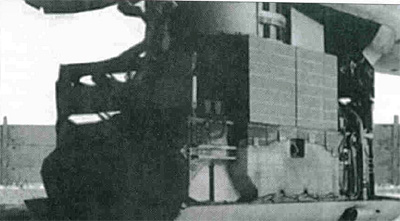 |
The nuclear engine was housed in the bomb bay. |
|
The NK Kuznetsov Design Bureau commenced work on the engines at the same time that the schematics of Aircraft 119 were drawn. As in the Tu-95LAL, the internal bomb bay would house the reactor. The connections leading from the reactor to the engines would run thru the main fuselage, up to the wings and then directly to the heat exchangers attached to the two inboard engines. Tupolev estimated that the first 119 were to be available for runway trials by late 1965. After trials, the 119 engines were to be replaced by a four NK14a engine configuration based on the Tu-114 commercial liner. However, the 119 never made it out of the drawing board. Budgetary constraints and the development of new conventional aircrafts designs were cited as the main reason for the cancellation of the program in August 1966.
The cancellation of Aircraft 119 did not mean that the Soviet Union terminated its research into a nuclear powered aircraft. Several attempts were made in designing a nuclear-powered, supersonic bomber. Around the same time that Tupolev began working on the 119, there was a parallel program code named Aircraft 120. Vast amounts of research hours were invested on this project. Most of them on the design of a new turbojet engine and the layout of a new nuclear reactor system that would have been able to offer more protection to the crew and the aircraft sensitive avionics systems. Aircraft 120 was to be fitted with two turbojet engines on development by Kuznetsov. The reactor was to be installed near the rear part of the plane, as far from the cabin as possible. The crew consisted of the pilot, co-pilot, and navigator; enclosed in a heavy lead radiation shielding cabin. The 120 would have a conventional aerodynamics configuration with a high mounted 45 degrees swept wing, a swept empennage and a tricycle landing gear. Tupolev’s goal of reaching the testing phase for the 120 in the late 1970s never materialized, as with the 119, the 120 existence was only on the drawing board. Termination of the program was mainly for the same reasons as for the 119’s. Next for Tupolev was the Aircraft 132. Another attempt by the Soviets to produce a serviceable nuclear powered bomber. The 132 was conceived as a low-level strike aircraft. The design 132 would have housed the reactor in the front two turbojet engines, the entire package would be accommodated in the rear of the airframe. The engines were to be designed to operate with nuclear power or with conventional kerosene. The kerosene would be only used for take-off and landing operations and the fuel would be housed in a tank installed in front of the reactor. As with the 120, the 132 would have had a conventional configuration, with the cabin, again, heavily shielded. The main difference was the wings configuration. The 132 would have been a delta wing plane. The empennage was also to be swept and the horizontal stabilizer was to be located on top of the fin. As with the other projects, the 132 was cancelled in the mid 1960s for budgetary and, most importantly, technical difficulties. |
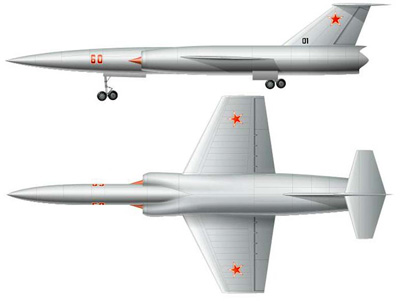 |
|
|
Initial M-60 with trapezoid wing. (Image courtesy of
Avicopress ©) | |
|
One last attempt was made by the Tupolev bureau to achieve a nuclear powered aircraft. This aircraft would have been supersonic, long ranged bomber designed to compete with Convair’s B-58 Hustler supersonic medium bomber. This time, the aircraft did not make it to the drawing board. In the late 1960s, the Soviet Union decided to abandon further research into the feasibility of a nuclear powered aircraft. The main reason given to the bureaus involved in the project was that with the introduction of more accurate and less expensive Inter-Continental Ballistic Missiles aboard nuclear powered Soviet submarines; the Soviet Union could achieve the same degree of nuclear capability at a fraction of the cost. Also, in consideration, but rarely mentioned by the Soviets, was the ecological impact of a crash during operations. Should one of these aircrafts were to crash in a populated area, the radiation fallout could have been disastrous.
Another nuclear powered aircraft program was started by the Myasishchev Design Bureau in the summer of 1955. On May 19th, 1955; a resolution passed by SovMin ordering Myasishchev to commence development of a supersonic nuclear bomber. The bureau first design was code name M-60. The first draft of the project was finished on July 1956. At the same time, Lyulka’s new engine design that would comprise a nuclear/turbojet engine with the heat the reactor generates transferred through air to the jet, a power plant configuration known as an Open System; would give the M-60 49,600 lbs of thrust. The aircraft would take-off and land with a chemical mixture fuel as its propulsion. On reaching the desired operational altitude, the nuclear system would engage and provide the M-60 with its cruise speed. This engine configuration and thrust would have given the M-60 the ability to achieve Mach 2 speeds. Crew accommodations were to be housed in the center of the fuselage, again, in an all enclosed, lead shielding cabin. The cabin configuration would have curtailed visual observation. Consistent with other Soviet nuclear configurations, the reactor would be housed on the rear of the aircraft to offer further protection. The initial fuselage configuration called for a long, slim airplane with trapezoid wings and a trapezoid T-shaped tail. The nuclear/jet engines were to be placed side-by-side in the fuselage. The length of the M-60 was proposed at 169 ft, 3.5in; with a wing span of 86 ft, 11in. Sub sequential designs modifications of the M-60 had the aircraft fitted with four engines, mated as pairs at the rear of the airframe. As with the other nuclear programs, a tricycle undercarriage was selected for the M-60. |
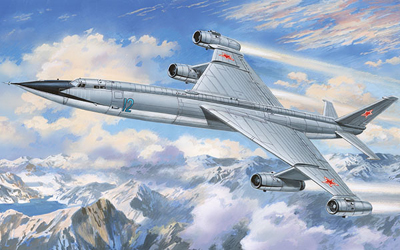 |
M-50 Bounder. |
|
Later, a swept wing variant of the M-60 design was introduced in December 1957— it called for the M-60 to be a delta winged design with both engines placed on under wing pylons and in tip nacelles which resemble the configuration of the M-50 Bounder. After extensive research, the Myasishchev bureau determined that with the correct nuclear power plants, a strategic bomber with a 1,989 mph speed, an operational range of 15,500 miles, and a service ceiling of 65,600 ft was achievable.
The M-60 also did not make it out of the planning stage. After the cancellation of the M-60 program in 1959, the Myasishchev bureau put much of its research assets on the M-30 program, which started back in 1953; but by this time, SovMin interest on a nuclear powered aircraft was waning. Several other attempts were made to design an operational nuclear aircraft, chiefly the M-30, but also the M-62 program, ran similar along the lines of the M-60 The final blow to the nuclear powered aircraft program came in early 1961, when the Soviet leadership called for the abandoning of all related programs, thus ending one of the their most expensive and technically challenging programs ever. The end of the M-60 and the M-30 was also the end of Myasishchev’s affiliation with the design and production of heavy bombers. At the time of the cancellation of the program, the overall state of available technology, atomic science and aerodynamic designs, had progressed to the point that if the program had run its service course, it is very plausible that the Soviet Union would have reached its goal of deploying a nuclear powered bomber platform by the late 1970s. Instead, the flow of new aerodynamic information and designs, the vast amount of economic resources needed in the program, not only to develop a nuclear powered bomber, but to maintain it were cited as the reason for the cancellation. Also the emergence of a new Soviet doctrine that would rely heavily on the new submarine launched ICBM; with improve targeting mechanism, coupled with the sheer number of Land Based ICBMs that the Soviets were rapidly deploying, doomed the Soviet nuclear power bomber program. At around the same time the Soviets commenced its nuclear powered aircraft program, the other Cold War warrior, the United States, was already working at a fast pace to field its own nuclear bomber, but that story is for another time@• The author Paul Colon is a freelance writer who resides in San Juan Puerto Rico. rcolonfrias@yahoo.com |
Sources
|
* Indigenous Bombers (1945-2000) Part I: SM Ganin, AV Karpenko, VV Kolnogorov; Bastion 2001 * Soviet X-Planes: Alan Dawes; Key Publishing 2001 * Yakolev Aircraft since 1924: Bill Gunston and Yefim Gordon; Putnam 1996 * Supersonic Myasishchevs; Piotr Butowski; Air Enthusiast No.82 Jan/Feb 1998 |
Return To Articles Index.
© The Aviation History On-Line Museum.
All rights reserved.
Updated March 7,2009.